CHAPTER 4
Chest
Most cyclists don’t spend much time developing their chest muscles. However, these muscles are important when taking the entire cyclist into consideration. The chest plays a fundamental role in connecting the rider to the bicycle via the shoulders and arms. As previously discussed, symmetry and balance are needed in order to enhance performance and avoid injury. A truly fit rider is one who has strong and balanced musculature; a cyclist needs a solid foundation to optimally perform. Whenever you’re riding, your back will be hypertrophying because of the strain of the cycling position. Because the chest muscles are mainly employed during extreme efforts such as climbing or sprinting, these muscles may not undergo the same adaptation as your back during your training rides. Therefore, you’ll have to pay special attention to your chest muscles while working out in the gym.
Your work in the gym will also pay off when you surge on your bicycle. Every time a cyclist powers up a climb or sprints away from the field, the chest muscles will be firing with a vengeance. The powerful downstroke of the leg will force the bike to swing to the side. This movement is countered by the stabilization of the bike at the handlebars. Without a solid foundation, much of the power transfer to the bike would be lost. Next time you see the end of a bike race, pay attention to the cyclists’ upper bodies and how each cyclist throws his complete self into the sprint. The chest, arms, and legs all help hurl the straining cyclist to the line.
Chest Musculature
The chest muscles are shown in figure 4.1 on page 56. The pectoralis major is the primary muscle of the chest, and it is composed of two anatomical sections that are each shaped like a triangle. The upper section, or clavicular head, connects to the clavicle and the manubrium of the sternum. It inserts onto the upper portion of the humerus. The lower section, or sternal head, of the pectoralis major originates on the sternum. The sternal head inserts just under the upper head of the pectoralis major on the humerus.
The primary role of the pectoralis major is adduction, flexion, and internal rotation of the arm at the shoulder joint. This allows your arm to make strong movements across the chest—such as moving your handlebars from side to side. Although there are only two anatomical sections of the pectoralis major, this muscle can be divided into three fairly distinct functional sections. Different muscle fibers in each of these three functional areas are activated based on the arm’s angle with respect to the shoulder joint. The exercises in this chapter are grouped according to this functional delineation, and divided into upper, middle, and lower focus points. During all these exercises, the entire pectoralis major is trained, but various sections will bear the majority of the workload.
The pectoralis minor is a small, externally nonvisible muscle that lies under the pectoralis major. The pectoralis minor originates on the upper margin of the third, fourth, and fifth ribs. All the fibers come together and insert on the coracoid process of the scapula. The primary role of the pectoralis minor is to lower the angle of the scapula, thus pulling the shoulder forward.
The serratus anterior muscle forms the side of your chest. This muscle wraps around the outside of the upper eight ribs and inserts along the length of the medial scapula. Its role is to pull the scapula forward and around the rib cage, similar to the motion that occurs when throwing a punch. That’s why this muscle is sometimes referred to as the “boxer’s muscle.” For the cyclist, the serratus anterior helps stabilize the scapula and shoulder. Many of the exercises in this chapter and chapter 6 will help develop the serratus anterior.
The anterior muscles of the chest are fewer and simpler when compared to the numerous muscles of the back. The three primary chest muscles (pectoralis major, pectoralis minor, and serratus anterior) will bear all the workload and counterbalancing duties. During your workouts, focus on the individual part of the muscle being trained (as described by the workout), and think about how this muscle will enhance your performance on the road.
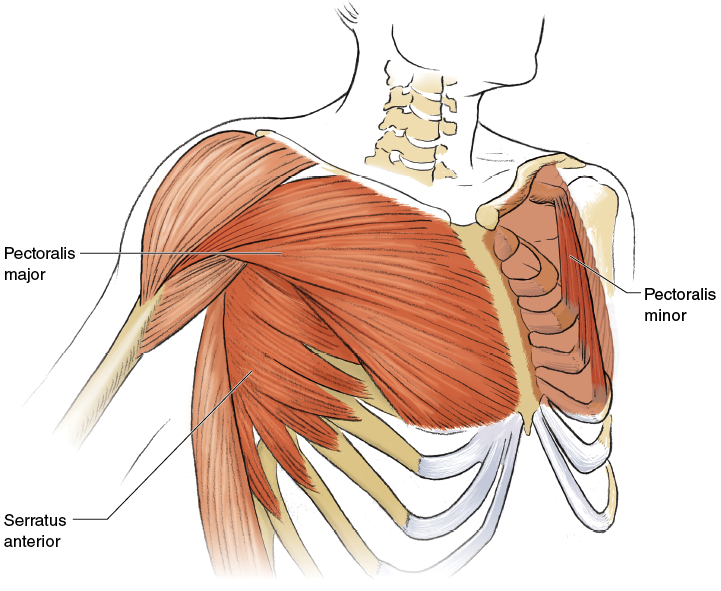
Figure 4.1 Muscles of the chest.
Warm-Up and Stretching
Warm up for 5 to 10 minutes with some sort of cardio work—treadmill, stair stepper, or rowing machine. Once you develop a sweat, focus on stretching your anterior torso. Stretch your chest by lying on the floor in the push-up position. Allow the pectoralis major and minor to stretch for 15 to 30 seconds. This works even better if push-up handles are available. Slowly perform a few knee-down push-ups until you feel warm. You can also warm up using the dip bars. Standing on a platform, mimic the dip motion. Using your legs as an aid, hold yourself in the down, arms-flexed position of a dip. Repeat this motion very slowly multiple times to adequately stretch your chest and arms.
Dip

Execution
1. Hold the dip bars with your arms extended and your chest leaning forward.
2. Bend your elbows and lower your body until your upper arms are parallel with the floor (elbows are bent to 90 degrees).
3. Push yourself back up to the starting position.
Muscles Involved
Primary: Lower pectoralis major, triceps
Secondary: Anterior deltoid, latissimus dorsi, pectoralis minor, levator scapula, teres major, rhomboid
Cycling Focus
Comparing the exercise illustration with a cyclist sprinting allows you to see the value in this workout. The dip is my favorite chest training exercise because it works so many muscles that support the upper body of the cyclist. The chest plays a key role in stability, power, and steering control when you are sprinting on your bike. The strength of your pectoralis major will allow you to steady the side-to-side movement of your bike while your legs produce a tremendous amount of torque during the sprint. All the energy of your legs should be used for forward propulsion, not frantically swinging the bike from side to side. The dip exercise will also strengthen your entire shoulder joint, providing added support and endurance for the countless hours you’ll spend leaning forward on your handlebars.
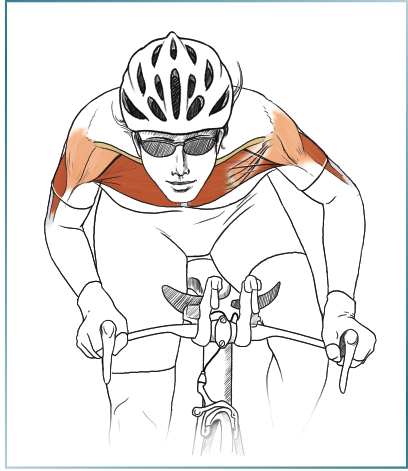
Variation
Machine dip: Dip assist machines can be used if you are unable to perform the exercise without any aid. Generally, these machines include a platform to place your knees on while you hold the dip handles. You dial in a weight setting, and the platform assists you in lifting and lowering your body during the exercise.
Decline Dumbbell Press
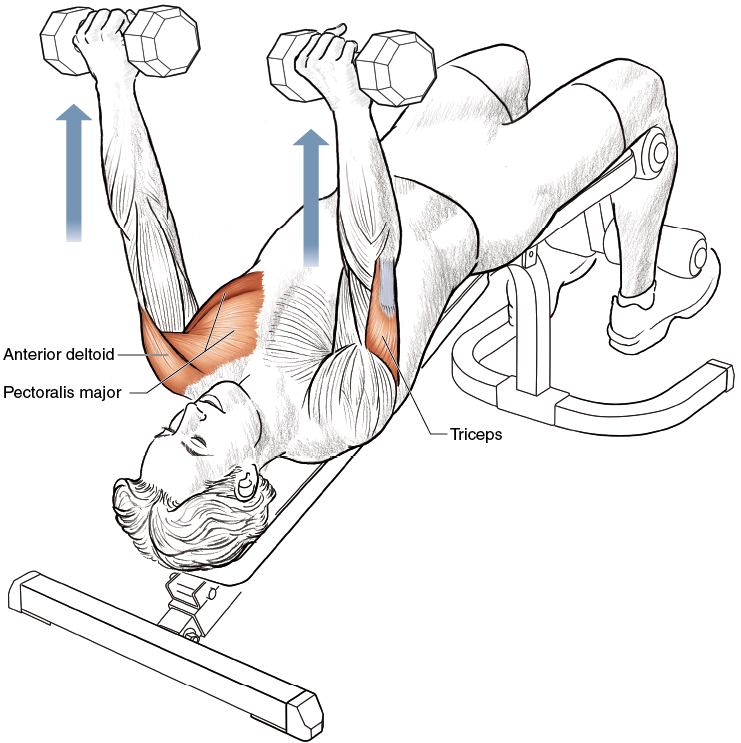
Execution
1. Set the decline bench at a downward angle of 20 to 40 degrees. Lie on the bench and hold a dumbbell in each hand. Your arms should be extended, and your palms should be facing away from your head.
2. Lower the dumbbells together to your chest. Your palms should continue to face away from your head.
3. Push the dumbbells up until you return to the starting position.
Muscles Involved
Primary: Lower pectoralis major
Secondary: Triceps, anterior deltoid
Cycling Focus
The position for the decline dumbbell press mimics your position on the bike when climbing with your hands on the hoods. As you stand out of your saddle to climb, you’ll be leaning forward with your torso to help drive the pedals around. This will increase the strain placed on your arms, shoulders, and chest. Your lower pectoralis major will help steady your bike and support the weight of your body over the bars. With each pedal stroke, your bike will want to rock from side to side. Your pectoralis major will keep this movement in check and help keep your form efficient.

Variation
Decline barbell press: The barbell adds extra stability to the decline press exercise. As you lower the bar, it will stop when it hits your chest. This will limit the potential for overflexion injury. The downside of using the bar is that it limits each arm’s freedom and range of motion. The more unstable the arms are during the exercise, the more the accessory muscles will need to be conditioned in order for you to maintain proper form.
Cable Crossover
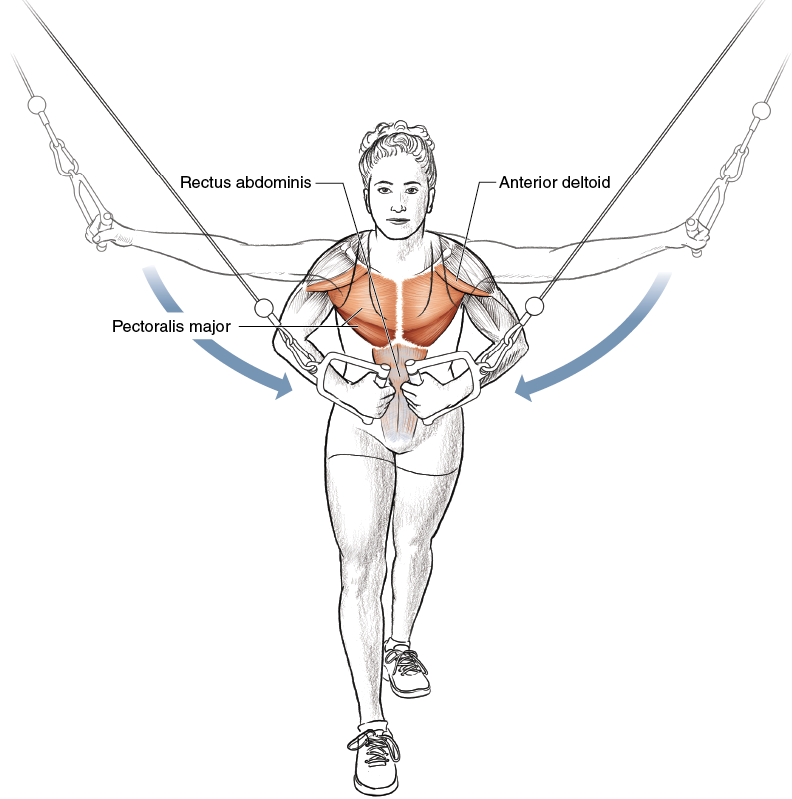
Execution
1. Grasp a high pulley handle in each hand and lean slightly forward. Your arms should be out to the sides with only a slight bend in the elbow.
2. Keeping your elbows locked, bring the handles together until your knuckles touch in front of your waist.
3. Slowly return your hands to the starting position.
Muscles Involved
Primary: Lower pectoralis major
Secondary: Anterior deltoid, rectus abdominis, forearm flexors
Cycling Focus
The start of the time trial is one of the more explosive moments in cycling. You need to quickly go from a standstill to race speed. The bike often has aero wheels and aero bars that can add to the inertia of the bike. As the clock clicks down and the referee lets you roll out, you’ll be driving the pedals with your entire might. With each leg driving downward, your upper body will be pulling to counteract the extreme force. This will require your pectoralis major, biceps, and abdominal muscles to forcefully contract. The cable crossover will help develop your body’s ability to execute this powerful contraction.

Variation
Seated Cable Crossover
You can perform this same exercise while seated on a stability ball. This is more difficult and will require additional activation of your abdominal muscles. You’ll notice that your entire core will be firm and contracting to keep your position stable.
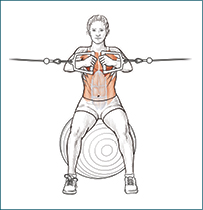
Bench Press


Safety Tip
Avoid arching your back when lifting the weight. This puts unnecessary strain on your back and prevents isolation of your pectoralis major.
Execution
1. Keeping your back flat on the bench, grab the bar with a grip that is slightly wider than shoulder width.
2. Starting with your elbows extended, slowly lower the bar to your chest.
3. Without bouncing the bar off your chest, return the bar to the starting position.
Muscles Involved
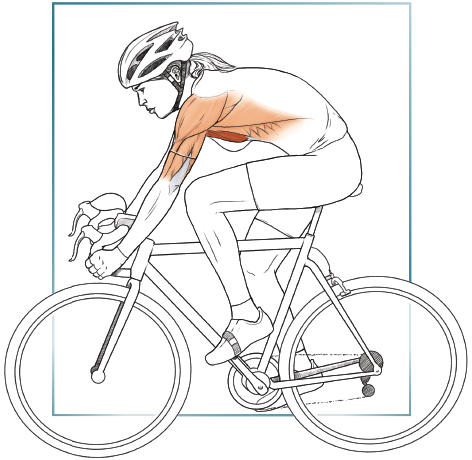
Primary: Middle pectoralis major
Secondary: Anterior deltoid, triceps
Cycling Focus
The bench press is one of the best-known exercises in the gym. It primarily works the pectoralis major muscles while allowing support of the back and spine. Cyclists can benefit from this exercise because it mimics the rider’s basic position on the bike. Whether your hands are on the tops, hoods, or drops of your handlebars, your pectoralis major will play the primary role in supporting your body. Look at the illustration here and you’ll see that the starting position in the bench press is very similar to your position while cruising on your bike. The long miles spent on your bike will slowly fatigue your body, and the better condition all your supporting muscles are in, the better you will ride.
Variation
Machine chest press: The machine chest press offers two advantages over the barbell bench press. The weight is easier to set up and adjust, and the machine provides more support. Remember to keep your back flat against the pad during the exercise. Form is more important than lifting a heavier weight.
Dumbbell Bench Press on Stability Ball
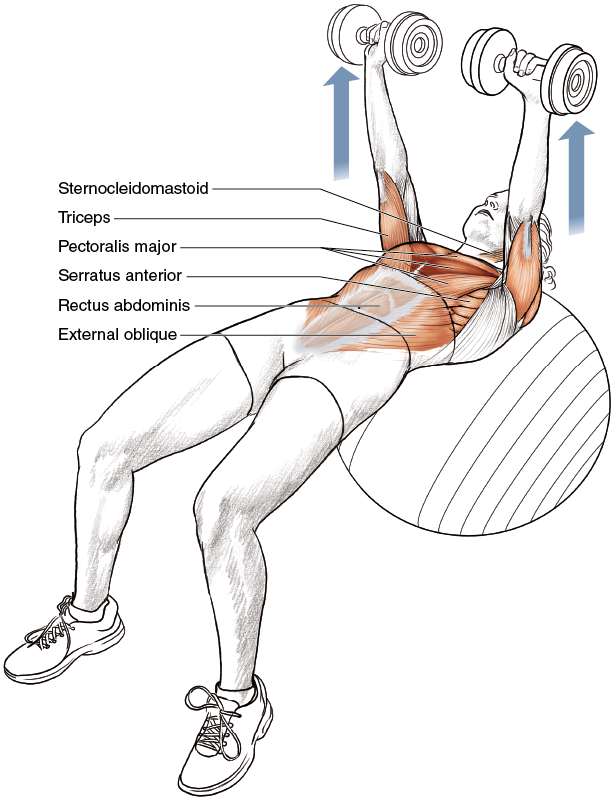
Execution
1. Lie back with your shoulders on a stability ball, keeping your neck and head off the ball. Hold a dumbbell in each hand with your arms extended above your chest. Your palms should be facing toward your feet.
2. Starting with your arms fully extended, lower the dumbbells together until they are at the level of your chest.
3. Slowly return to the starting position.
Muscles Involved
Primary: Middle pectoralis major
Secondary: Anterior deltoid, triceps, sternocleidomastoid, rectus abdominis, external oblique, internal oblique, serratus anterior
Cycling Focus
I love this exercise because it not only works the arms and chest, but also works the neck flexors and abdominal muscles. The instability of the exercise ball adds an increased degree of difficulty; therefore, you’ll likely have to use a lighter weight than you use when performing the barbell bench press. When using a barbell or a machine, your weak arm will often gain extra support from your strong arm during the bench press. By working with dumbbells on an unstable ball, you’ll definitely be forcing all your accessory muscles as well as each pectoralis major to perform their fair share of the work. Again, you can see that the exercise position closely resembles a common position on the bike.

Variation
Single-arm dumbbell bench press: Mix this variation into one of the sets when performing the dumbbell bench press. By working one arm at a time, you will increase the work of your trunk stabilizers. You will find that this places extra stress on your abdominal muscles, obliques, and back.
Medicine Ball Push-Up
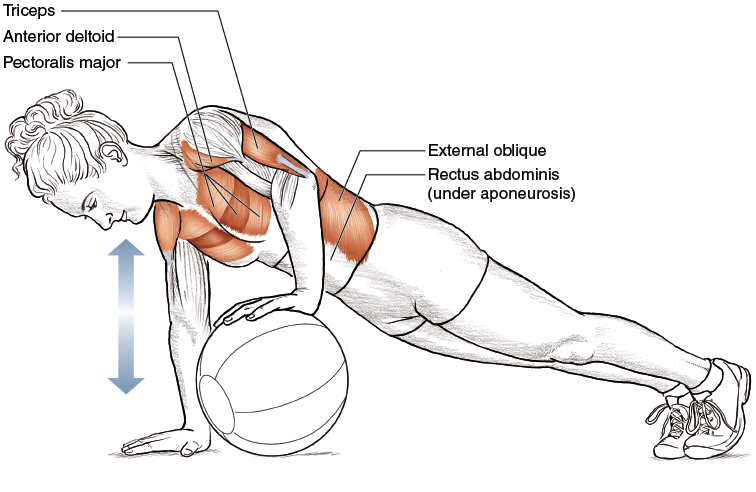
Execution
1. Assume the standard push-up position, but place one hand on a medicine ball and the other hand on the floor. Keep your back straight and flat.
2. Keeping your back flat with the plane of the ground, lower yourself until your chest nearly touches the ground.
3. Return to the starting position (elbow extended).
4. Repeat the set with the medicine ball on the opposite side.
Muscles Involved
Primary: Middle pectoralis major
Secondary: Anterior deltoid, triceps, rectus abdominis, external oblique, internal oblique, serratus anterior
Cycling Focus
The push-up is an excellent training exercise for cyclists. This exercise doesn’t add much bulk, but it strengthens your arms, chest, shoulders, back, and torso. By adding the medicine ball, you’ll get increased range and flexibility as well as stronger muscles. During your rides, you’ll spend almost all of your time in a position that is similar to the push-up position. A stable body sets a strong foundation to power the pedals. When fatigue sets in, you’ll start to lose form. And as your form falters, your efficiency will wane. You can add strength and endurance to your rides by working the push-up in the gym.
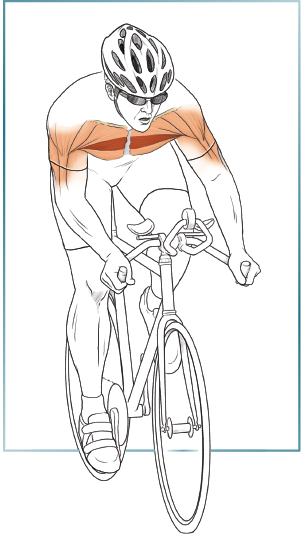
Variation
Stability Ball Push-Up

Safety Tip
Make sure you work up to this variation. If you don’t have a good grip on the stability ball, your hands can slip, which may result in injury.
Doing push-ups on the stability ball adds an extra degree of difficulty. Not only do you need to perform the push-up motion, but you also need to stabilize your body to keep the ball from moving. Additionally, you have to compress the sides of the ball inward so that your hands don’t slip downward to the floor. Start this exercise with your feet on the floor (see figure a). If you want increased difficulty, try to perform the push-up with your feet resting on top of a bench (see figure b). Once you’ve mastered the bench version, try lifting one foot off the bench while keeping your knee straight. This makes the exercise very tough.
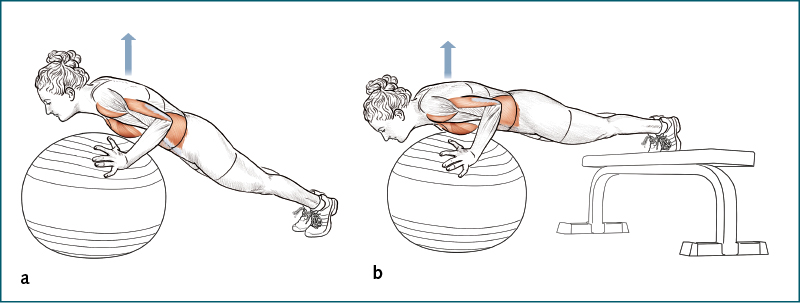
Incline Dumbbell Press

Execution
1. Sit on an incline bench and hold the dumbbells using a palm-out grip. Your arms should be extended.
2. Lower both dumbbells vertically until your elbows are flexed and the dumbbells are at chest level.
3. Slowly return the dumbbells to the starting position.
Muscles Involved
Primary: Upper pectoralis major
Secondary: Anterior deltoid, triceps, serratus anterior
Cycling Focus
You’ve been on a solo break, and now it comes to this: You’re sprinting toward the finish line, and you can sense the other riders closing in and wanting to swallow you up. You make a last surge for the line and throw your bike forward to just nose out the rider next to you. Fortunately, you were ready because you trained so hard. The incline press enabled you to train the very muscles you used to thrust your bike in front of your opponent at the last minute. You’ll also achieve other gains from this exercise. Like the other exercises in this chapter, the incline press will fortify your torso stability and help prevent the fatigue that can result from spending the day leaning forward on your handlebars.
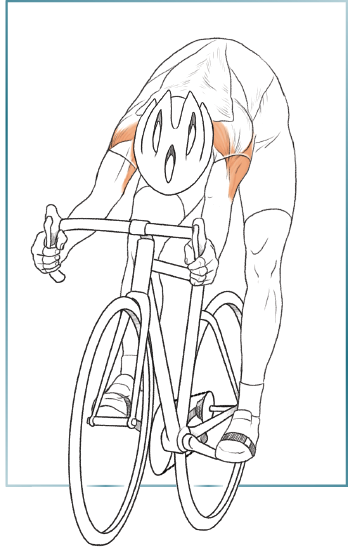
Variation
Incline barbell press: Another option is using a barbell on an incline bench. This will offer you added stability and limit the downward movement because the bar will rest on your chest. If you find it difficult to set up the exercise with dumbbells and to keep them steady, then the barbell is a good option for you.
Stability Ball Dumbbell Fly
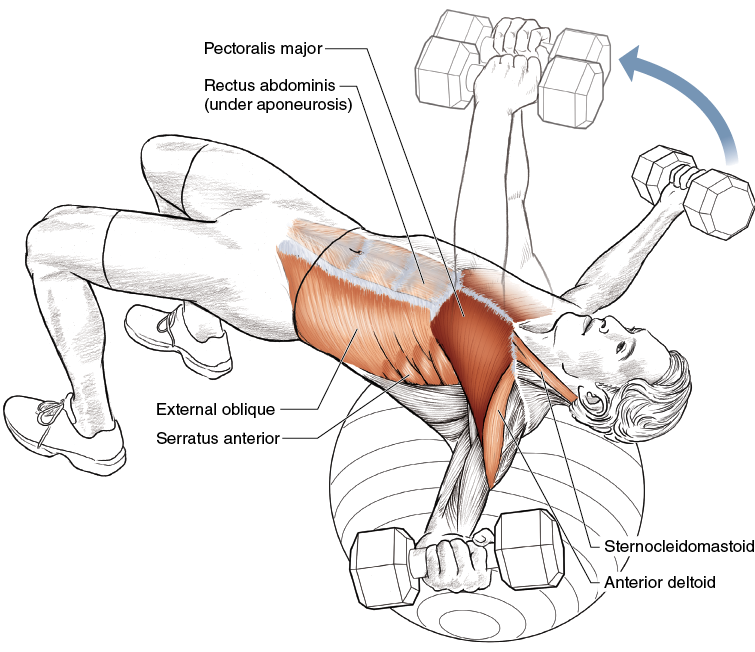
Execution
1. Lie back with your shoulders on a stability ball, keeping your neck and head off the ball. Hold a dumbbell in each hand with your palms facing inward.
2. Start with your arms out to the sides. Your elbows should have a slight bend (150-degree angle between the upper arm and the forearm).
3. Keeping your elbow angle fixed, slowly bring the dumbbells together above your chest.
4. Return to the starting position.
Muscles Involved
Primary: Pectoralis major
Secondary: Anterior deltoid, sternocleidomastoid, rectus abdominis, external oblique, internal oblique, serratus anterior
Cycling Focus
The end of a time trial is brutal. You’ve given everything you have out on the road, and now you have to motivate your machine to show a burst of speed for the last 100 meters. With each trouncing of a pedal, your bike will want to swing out to the side. Your arms and chest prevent the movement from sapping too much of your power or control. You can see from the image that the cyclist’s arm position is close to the position of the dumbbell fly workout. Remember, you want all the energy to be moving your bike forward. Therefore, you need to use your pectoralis major to maintain the vertical plane of the bicycle.

Variation
Pec Deck
The pec deck isolates the pectoralis major. Make sure you use good form and keep your back tight against the pad. Focus on using your pecs rather than trying to manipulate your arm position to get extra leverage.

Dumbbell Pullover
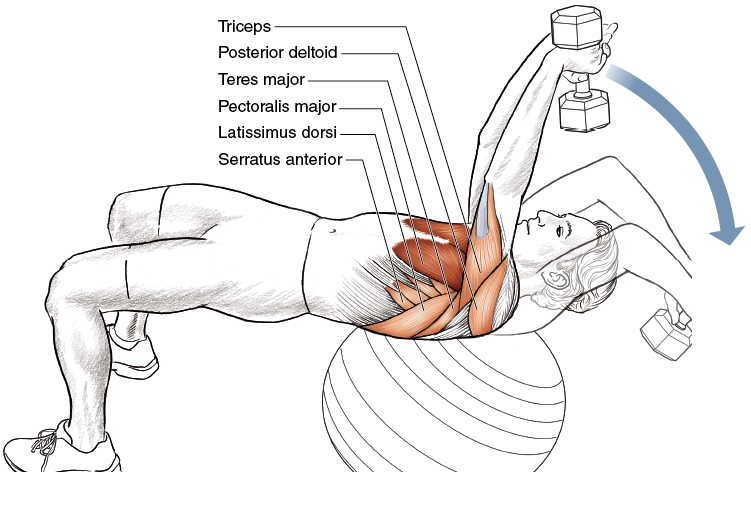
Execution
1. While lying with your back on a stability ball, grasp the inside edge of the weight plate of a dumbbell with both hands.
2. Starting with the dumbbell above your chest, and keeping a slight bend in your elbows, slowly lower the dumbbell downward and backward until it reaches the level of your head.
3. Keeping your elbow angle consistent, bring the weight back up to the vertical position by rotating at the shoulders.
Muscles Involved
Primary: Pectoralis major
Secondary: Latissimus dorsi, serratus anterior, teres major, posterior deltoid, triceps, rhomboid, pectoralis minor
Cycling Focus
Powering through a long straightaway on a time-trial bike will force you to use many of the muscles trained in this exercise. Midway through the motion of this exercise, you’ll find that the position is very similar to a rider stretched out in aero bars. During each forceful pedal stroke, you’ll pull back on the bars to drive your foot through the pedals. Simply put, the key to time trialing is going fast. A professional racer and friend of mine recently had a revelation about riding fast in time trials. He said, “You just have to step on the pedals harder—secret of the pros!”
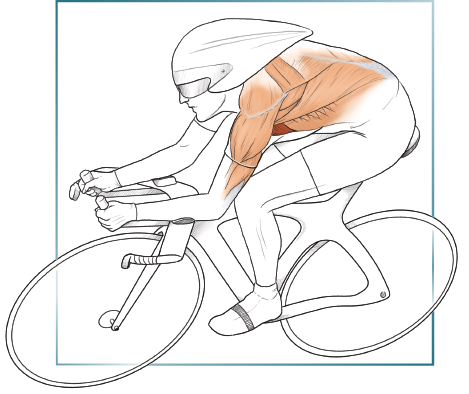
Variation
Machine pullover: Getting into position for this exercise on a stability ball can be awkward and difficult. The pullover machine offers a good alternative and works the same muscles.